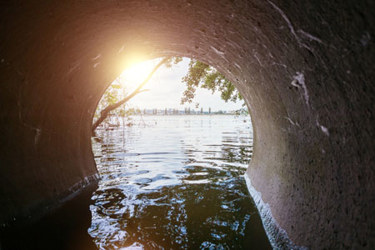WWEMA Window: Designing Wastewater Treatment Equipment For Resiliency
By Stacy Belanger

It is a known issue that wastewater infrastructure is aging and is in need of significant investment to upgrade or replace systems to operate safely. Age is not the only factor driving system replacements. Wastewater itself has changed, which means what flows through collection systems and into treatment plants is different than what it was 50 years ago. At home, lower-flow toilets translate to less water to move flushed solids. And those solids include materials such as non-dispersible wipes that are not designed to disintegrate in water. Out on the streets, there are more plastics and other non-biodegradable items that make their way into sewer systems. And let us not forget how climate change and the resultant increase of extreme weather events impact wastewater systems. As I write this article, Hurricane Idalia has just finished passing over Florida and other southern states this week and will likely not be the last hurricane to make landfall in the U.S. this season. A few weeks earlier, Tropical Storm Hilary was the first tropical storm to hit Southern California in 84 years. Not only is hurricane activity increasing, but higher-strength storms are making landfall with higher frequency. These storm systems introduce an extreme influx of flow and debris into wastewater systems that are not always successful processing all the flow. And hurricane activity is not the only weather extreme of concern. We only need to look back to February 2021 when many Texas water systems suffered weather related damage during an extreme freeze.
Fortunately, there are existing equipment solutions to address these challenges and to design a resilient system. Equipment manufacturers are happy to work with municipalities and engineering firms to develop the best solution for the challenges expected today as well as in the future. Industry challenges that do not have existing solutions drive innovation as manufacturers work with customers to develop viable solutions. The key is that customers need to articulate the problem that needs to be solved and not just accept what they have used in the past is or will be the best solution available.
The impact of climate change should be one of the considerations when designing new or upgraded systems. The 100-year storm is becoming the 50- or 25-year storm. Extreme temperatures are more common. Fortunately, there already exists a lot of equipment suitable to operate in these extreme weather events. Municipalities and the engineering firms just need to be forward-thinking about what the potential weather challenges are so that the right equipment is specified. An example is that most equipment used in wastewater treatment have a solution to operate in freezing temperatures. It is a relatively small investment to include cold-weather protection with equipment at the time of installation versus the expense incurred when equipment is inoperable or damaged during an unexpected freeze event. Yet cold-weather protection is typically only required in locations that routinely experience freezing conditions. Identifying potential extreme weather events and incorporating preventative measures can allow systems to operate during weather events that were unimaginable 50 years ago.
The debris in wastewater has also changed. Plastic and other non-biodegradable items are an everyday part of our life, and that material unfortunately makes its way into wastewater. It is necessary to remove this material to make sure it does not negatively impact the environment as well as the effectiveness of wastewater treatment processes. Also, as noted earlier, lower-flow toilets, which are very important for water sustainability, mean there is less water to move the debris. Collection systems need to be designed or upgraded to handle a higher concentration of solids to move them to wherever in the system they are to be removed. Again, I think there is a lot of proven equipment available to address these challenges. There are a variety of screen designs, some with screening media openings less than 1 mm. There are different pump designs to handle the solids in flow. And there are alternate solutions, such as grinders, to process the solids such that they are not a problem in the flow. Evaluating the different solutions to address the challenges presented by debris in wastewater will allow one to determine what is the best solution for their operation.
Resiliency should be important design consideration for wastewater systems. For the best solution, it should be a collaborative process with equipment manufacturers to select the best available technologies to address the challenges facing collection and treatment systems. WWEMA is actively involved in keeping its membership informed of the top challenges facing the industry. It facilitates connections between its members and industry experts, policymakers, potential customers, and other key stakeholders to place them in the best possible position for success. Equipment manufacturers are ready to support the industry to offer the best solutions to solve the wastewater challenges of today and tomorrow.
Stacy Belanger is a Product Manager at JWC Environmental. Belanger serves on the Water and Wastewater Equipment Manufacturers Association (WWEMA) Board of Directors. WWEMA is a non-profit trade association that has been working for water and wastewater technology and service providers since 1908. WWEMA’s members supply the most sophisticated leading-edge technologies and services, offering solutions to every water-related environmental problem and need facing today’s society. For more information about WWEMA, visit www.wwema.org.
